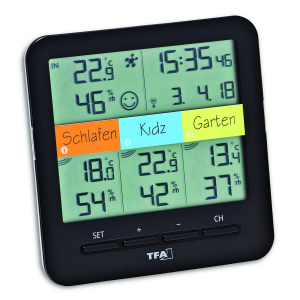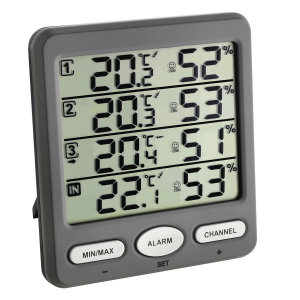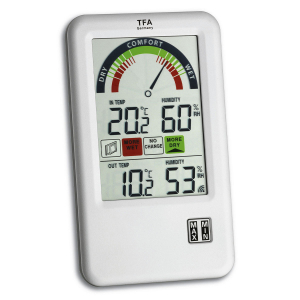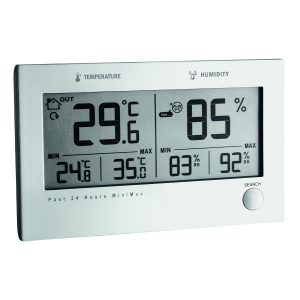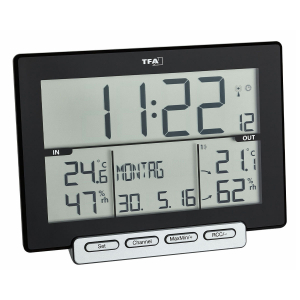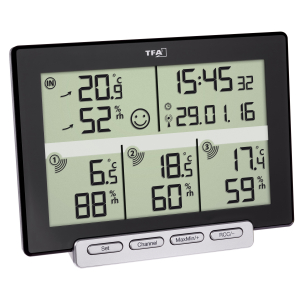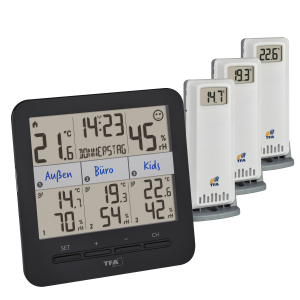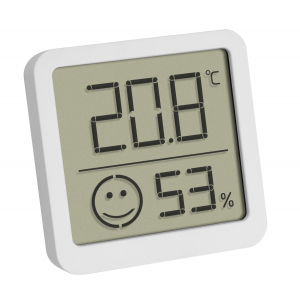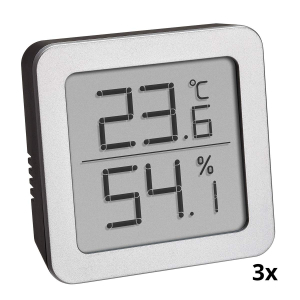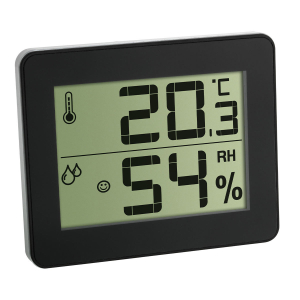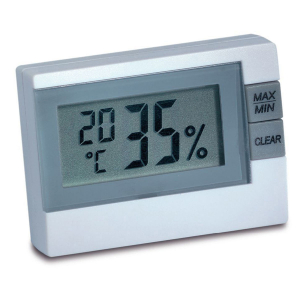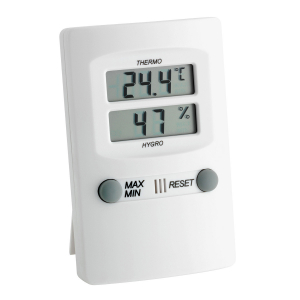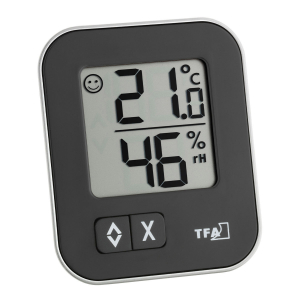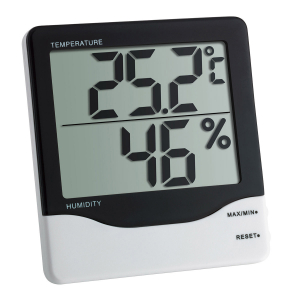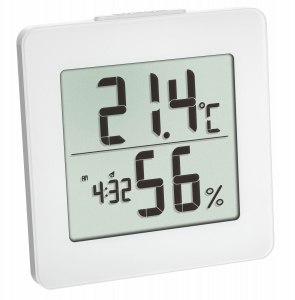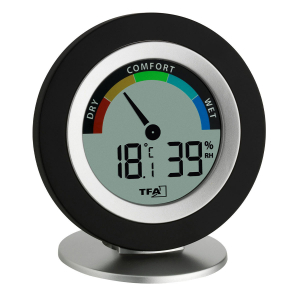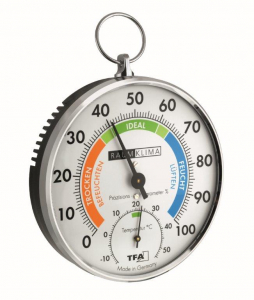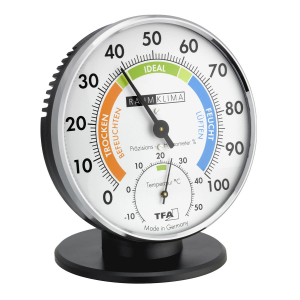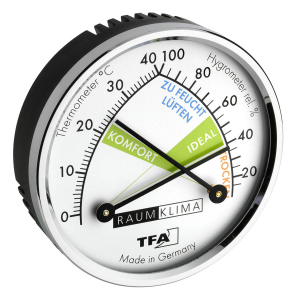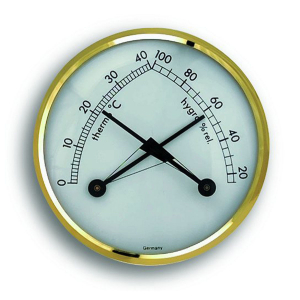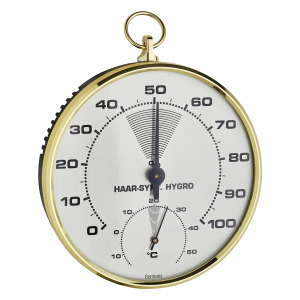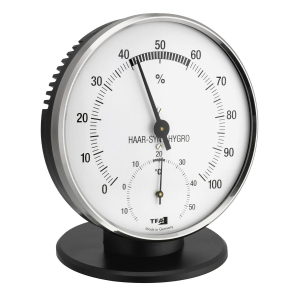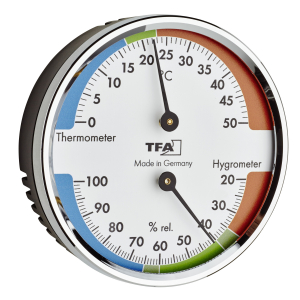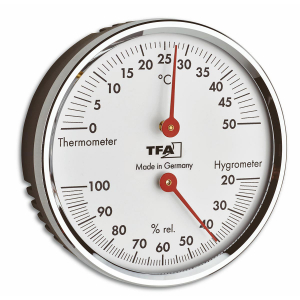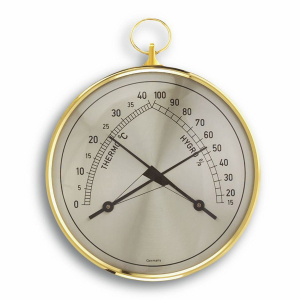A hygrometer is a measuring device for determining the relative humidity of the air. With the help of the determined values, conclusions can be drawn about the quality of the ambient air. Most hygrometers on the market are combined with a thermometer. The combined thermo-hygrometers offer temperature measurement and humidity measurement in one device.
Is the air too dry or too humid? Is there a risk of mold in living spaces? Does my room have the ideal humidity? All these questions can be answered with the values of a hygrometer and you can immediately see whether the humidity is optimal. In our hygrometer guide, you will learn what types of hygrometers there are, how the humidity meters work and are operated and we answer the most common questions about hygrometers.
Buy hygrometers from TFA Dostmann
If you want to buy a specific thermo-hygrometer, then look in our online retailers.
Wireless thermo-hygrometers
Wireless thermo-hygrometer with ventilation recommendation BEL-AIR
Item number: 30.3045.IT
+ 360° VIEWDigital thermo-hygrometers
Analogue thermo-hygrometers
All products of Thermo-hygrometers
Hygrometer guide
With a hygrometer, you always have the air humidity in view. Humidity measurement is especially important indoors. But hygrometers can also be useful outdoors.
> What types of hygrometers are there?
> What is a hygrometer used for?
> How is a hygrometer operated?
> Important questions and answers about hygrometers
What types of hygrometers are there?
To measure the humidity in the ambient air, we have several options today. Depending on the purpose of use and taste, you can use an analogue hygrometer or a digital hygrometer. In addition, there are hygrometers with wireless transmission, which transmit the measured data from the transmitter to the base station.
Digital hygrometer
Digital hygrometers measure air humidity by means of a sensor whose electrical properties change depending on the air humidity.
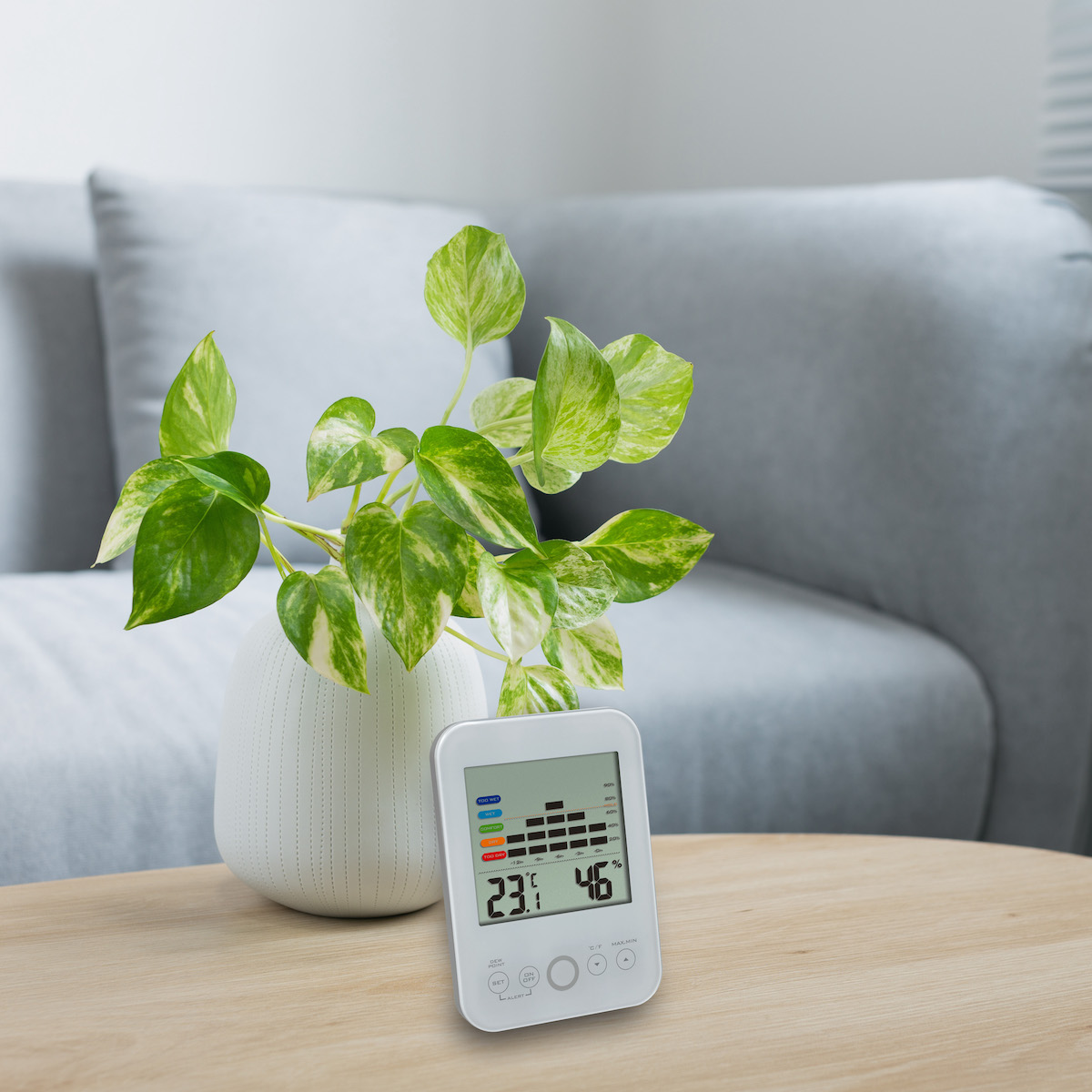
Fast humidity measurement with a digital thermo-hygrometer.
A distinction is made between the capacitive measuring principle, which is based on the changes in the electrical capacitance of the sensor, and the ohmic measuring principle, which uses the different electrical resistance to calculate the humidity.
The digital hygrometers from TFA are ready for operation after inserting the batteries. They measure the humidity of the ambient air at the place of installation within a few moments after sufficient acclimatization. For the industry, there are special professional thermo-hygrometers.
Wireless hygrometer
Wireless hygrometers send the humidity values by radio to the indoor base station. The advantage is that several rooms or the outdoor area can be monitored.
In combination with a weather station or a WeatherHub Smarthome Set, wireless technology is also used. The measured values are transmitted from the transmitter to the base station or an app. Reading the device is convenient and it offers additional functions such as maximum, minimum, or alarm values.
Analogue hygrometer
The analogue hygrometer was invented in the 18th century by Horace-Bénédict de Saussure, a Swiss physicist. He took advantage of the property of human hair: when the humidity rises, the hair expands and contracts again when the air becomes drier.
Blond female hair in particular was considered ideal because it is especially thin. Analogue hygrometers are therefore also called absorption hygrometers. The measurement is made with the help of water-attracting (hygroscopic) materials.
Today, the hair is replaced by a synthetic material with hygroscopic properties. The change of the expansion depending on the humidity is transferred to the pointer by precision mechanics. A scale is then used to read the relative humidity.
TFA uses two different analogue hygrometer movements, which are manufactured in-house: At the heart of TFA’s patented and particularly precise hair synthetic hygrometer is a synthetic hair. In the spring hygrometer, the humidity is measured by means of a coated bimetallic spring.
Analogue hygrometers operate without electricity or batteries. Unlike digital instruments, analogue hygrometers must be periodically regenerated and readjusted if necessary.
What is a hygrometer used for?
With a hygrometer, you can measure the humidity in the room. Predominantly, hygrometers are used indoors to control the indoor climate.
Most hygrometers are combined with a thermometer and thus offer humidity and temperature measurement. Humidity and temperature are closely related. Warmer air can absorb more water vapor. Colder air has a lower capacity to absorb water. Therefore, one also speaks of relative humidity.
Indoor hygrometer
Whether you feel comfortable in a room is largely dependent on its indoor climate. Depending on the room, a certain relative humidity should prevail.
The hygrometer helps you to determine when the humidity in the room is no longer optimal and, for example, needs to be ventilated. Proper ventilation plays a major role in achieving the ideal indoor climate. Tip: Observe the development of the hygrometer while ventilating to get an impression of the effect of your ventilation behaviour.
A hygrometer is also useful during the Corona virus pandemic. This is because studies prove a link between Corona virus transmission and humidity:
- Low humidity and very low temperatures allow viruses to survive long on surfaces and in the air.
- In contrast, higher temperatures and humidity can limit the spread of the corona virus.
A common problem of incorrect room humidity is mold growth. In the long run, too much humidity can lead to the development of mold. With the help of a hygrometer, you can prevent mold and keep the humidity in your rooms below the critical value of 65 percent.
But air that is too dry is also bad for your health. It promotes infections and can lead to various symptoms.
Hygrometer for outside usage
If you want to know how high the humidity and temperature is outside, you need a weatherproof device or a digital wireless model with an outdoor sensor. In meteorology, humidity also plays a role in predicting the weather.
Hygrometers for professional applications
For devices in professional use, they can also be equipped with a certificate. For these measuring instruments with a certificate, a test protocol is issued that documents and confirms the metrological properties, making the measurement results traceable to official standards.
If you want to evaluate the humidity data in the long term, you should use a device with a data logger function. With these measuring devices, you can store several values in individually adjustable storage intervals. These can be transmitted to a PC via USB.
How is a hygrometer operated?
The commissioning of a hygrometer differs according to the type of device and is explained in the operating instructions. For optimal operation, place the meter in a suitable location. Analogue hygrometers also need to be regularly regenerated and adjusted if necessary.
Where do I set up a hygrometer?
Depending on the variant of the hygrometer, you can set it up or mount it on the wall. In order to be able to measure the air humidity, the choice of the installation location should be made carefully. You should consider the following conditions:
- a central and well-ventilated place
- not directly next to a heat source or on an outside wall
- if possible, not in the immediate vicinity of windows and doors
Calibrate hygrometer correctly
Analogue TFA hygrometers are adjusted ex works. However, transport, storage or even long-term use in a drier environment will affect the hygroscopic functionality of the bimetal spring or synthetic hair.
To keep your hygrometer in top shape, we recommend that you regenerate the measuring instrument at least every six months and readjust it if necessary. This process is colloquially known as calibration.
Regenerating analogue hygrometers
Regeneration is primarily about restoring the ideal condition of the sensitive materials. Please proceed as follows:
- Soak an ordinary dish towel with warm water and wring it out again completely so that it no longer drips.
- Wrap the device completely in the towel for 15-30 minutes.
- Upon removal, the displayed humidity is ideally in the range of 90 to 99% rH.
- However, please note that a damp cloth will not provide a clear reference reading.
Readjusting analogue hygrometers
If readjustment is necessary, this should not be done immediately after regeneration. First, the hygrometer should be calibrated with several other hygrometers or a precision reference instrument under normal room conditions after regeneration.
Please pay attention to the following points:
- The instruments must be placed immediately adjacent to each other under identical conditions, ideally with some air circulation.
- Give the instruments 30-45 minutes to acclimate. We recommend that you use a timer for this.
- On the back, there is a small slotted screw or recess with a plastic slot in one of the holes. Using a fine slotted screwdriver, you can now set the pointer on the front to the determined value by carefully turning it.
Tip: The closer the reference value is to the subsequent ambient conditions, the more accurate your measurements will be. So, for dry rooms, adjust in the lower range, and for use in humid environments, adjust in the upper range.
